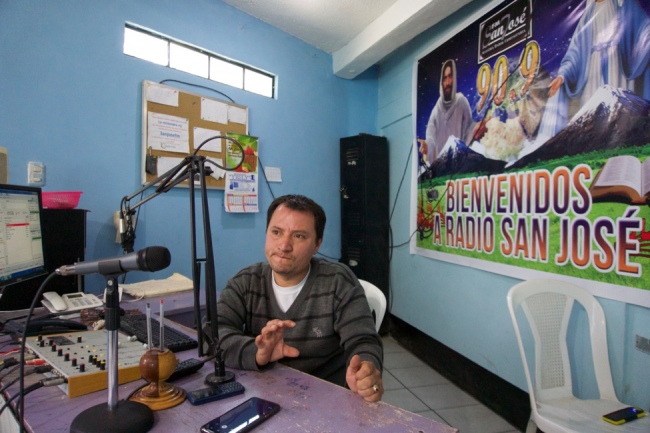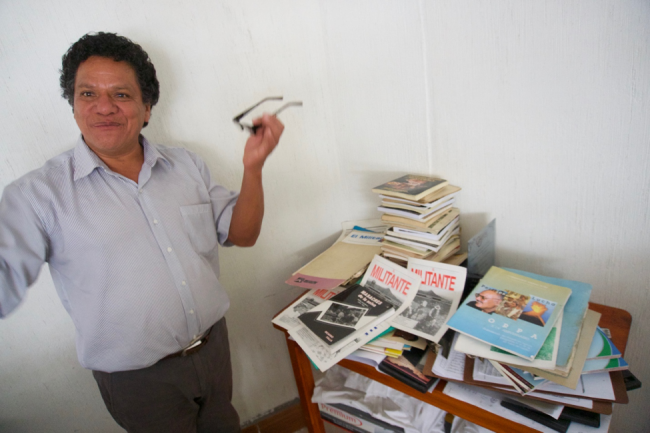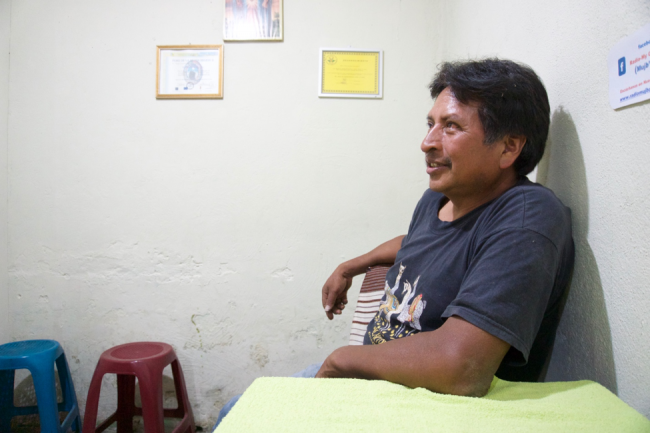
From a pasty blue building behind a crumbling church in a Guatemalan highland village, a contortion of antennas stands raised against the sky.
Beneath the antennas is a metal-plated door. Behind that, in a sparse room with a paint-chipped table and a sprawling tangle of wires, sits Osmar Miranda, a radio operator. Adjusting the black knobs on a control board, he takes off his headphones and explains how Radio San José—one of the Central American country’s so-called “pirate radio” stations—offers its poor Mayan population one of the few ways to get their voices heard on the airwaves.
“Here in Guatemala,” says Miranda, “the role of the radios comunitarias (community radio stations) has been to give space to the poorest communities so that the people can express what they want—you know, ‘I want to speak, I want to say what I feel.’ You can’t do that in commercial radio.”
As he speaks, a man behind him is recounting, on-air, how his prison stint brought him to God, opening his eyes to the reality of social injustice. The day’s subsequent programs will discuss issues of political consciousness, alcoholism, addiction, and ecological crises, interspersed with periodic renditions of Marimba—Guatemala’s national music.
Radio San José is part of Asociación Mujb’ab’l Yol (“Mujb’ab’l Yol” means “Meeting of Ideas” in the Mam Maya language), a network of radios comunitarias that spans six departments, or states, in Guatemala’s mountainous southwest, where the majority of the population is Indigenous Maya. Despite constituting 40 percent of this Central American country’s population, Guatemala’s Indigenous peoples are rarely represented in their country’s media.
Radios comunitarias—local, volunteer-run, Indigenous-language radio stations—have worked to fill this media void, working to represent and stand up for Guatemala’s largest, but often silenced, minority. The government refuses to legalize them on the grounds that they “use unused frequencies.” Critics contest that this is legal chicanery, a pretext wielded to punish them for their real, unspoken crime: having created a platform for the voices of Indigenous people, the bête noire of the Guatemalan government.
Guatemala’s Indigenous people have long experienced persecution. They were forced into indentured servitude on coffee plantations in the early 1900s. They suffered a genocide at the hands of the military in the 1980s. And now, they’re being forced off their lands and assassinated in rising numbers as they resist the intrusion of transnational corporations into their territories.
Radios comunitarias like those in Asociación Mujb’ab’l Yol are comprised of socially conscious programming, presented in both Spanish and Indigenous languages, with content designed to raise awareness of political issues in marginalized Indigenous communities. By pricing time-slots, or unused sections of the day’s broadcast, at far lower rates than corporate radio stations, they encourage underfunded community organizations to get their voices heard on the airwaves, stimulating grassroots political conversations at the local level.
It’s all part of an ambitious mission: to reconstruct Guatemala’s moribund democracy from below. “Rebuilding,” as Alberto Tino Recinos, a social activist, former guerrilla, and founder of Mujb’ab’l Yol says, “the social fabric that was broken during the civil war.”

Borne out of Conflict
The social fabric Recinos refers to was destroyed during the civil war that wracked Guatemala from 1960 to 1996, a conflict that saw a scorched-earth genocide against Indigenous people from 1981 to 1983, killing roughly 100,000 people in a conflict that already consumed a quarter million lives.
The war’s myriad effects fed directly into the country’s current miasma of gang violence and political corruption. The former “death squads” that murdered thousands of social activists coalesced with traumatized, teenaged war refugees who’d escaped to the U.S., only to be deported back to Guatemala. Together, they created gangs like MS-13 that now terrorize Central American communities. And the enormity of the killings themselves—626 villages were wiped out entirely by the military during the war—terrified people so much that remaining silent in the face of injustice became a survival strategy, fostering a culture of impunity in which crimes almost always go unreported, unchallenged, and unpunished.
Today, many fear Guatemala is backsliding into deeper political corruption in the run-up to its August 11 runoff presidential elections. They come after the controversial expulsion of a UN-backed anti-corruption commission and a rising spate of assassinations of Indigenous activists.
Amidst this chaotic political climate, radios comunitarias struggle to keep the voices of Indigenous people heard in the national conversation.
“Radios comunitarias speak in the language of the population,” says Roelio Fuentes, the founder of Radio San Jose. “If a radio comunitaria is in a region where a Mayan language is spoken, they do a lot of their programs in that language. They aren’t transnational (corporate) radios, nor radios that come from the capital, nor those that come to graze over our people’s culture. But the radios comunitarias faithfully express the feelings and beliefs of the community—in their own language.”
The members of radios comunitarias themselves don’t refer to their organizations as “pirate radios.” That epithet originated from the Guatemalan government, which through legal trickery has kept small radios representing Indigenous people suspended in a state of illegality. As a result, they’ve yet to be formally recognized—and therefore protected—under the law.
In the 1996 Peace Accords that ended Guatemala’s civil war, one of the key concessions made by the government was the right of Indigenous peoples to have their own means of communication. But in the years since, many have accused the government of reneging on this promise by finding loopholes in their lack of legal formalization. The Indigenous people’s advocacy group Cultural Survival calls it a “legal grey area” to criminalize and shut down radios comunitarias when politically expedient.
“Right now, we have a lot of fear of persecution,” says Felix Cabrera, the leader of Radio Concepcion, another community radio enmeshed with Mujb’ab’l Yol. “State authorities always tried to persecute radio journalists. They criminalize us. There isn’t a law that explicitly protects people’s right to express themselves.”

Illegality, or Racism?
Many say that government hostility towards Indigenous radio stations can be traced back to the centuries-old-racism directed towards Indigenous people. Guatemala remains extremely unequal, and the pervasive divide between Ladinos (white Guatemalans with little Indigenous blood) and Mayan masses still results in Indigenous peoples being regarded as unworthy of participating in the national conversation.
“The radios comunitarias have been very persecuted by the government, especially by purely political interests—or, by the monopoly, or oligopoly, if you will,” says Fuentes.
Evelyn Blanck, a journalist and activist with Asociación Centro Civitas, a Guatemala-based organization promoting democratic values, says that one of the loopholes used by the government to criminalize radios comunitarias is to accuse them of tapping into unused radio frequencies.
“They use a legal code to say that they (the radios comunitarias) are stealing a frequency,” Blanck says. “But a frequency cannot be stolen. And they do this to criminalize the radios and take their equipment away.”
That exact scenario transpired in February 2014, when state security forces raided Radio San Jose and stripped it clean of nearly everything—including the lone operator working the station that day. The raid on the station, a crumbling building in the village of San Jose, in the mountainous San Marcos department, was unannounced. Many say it was an attack not only on a local radio station but on radios comunitarias as a whole.
The pretext used to justify the raid was that the radio station was “inciting violence” and “not paying taxes,” despite the government’s refusal to legalize it. But many suspect it was meant to send a message of intimidation to radios comunitarias that amplify the voices of Indigenous peoples.
“A mountain of police came here,” says Miranda. “Twelve patrols, six men each. The public minister came soon behind them. They arrived, and the young man who was here unfortunately left the door open. So they were able to get in, seized all the equipment, the transmitters, everything. They left the room clean and took the operator away.”
After a month of despairing over their inability to free the radio operator—imprisoned but uncharged—the citizens of San José took matters into their own hands, kidnapping two police officers and sparking a showdown between the community and law enforcers.
A commission between three officials—a representative from COCODE, a government rural development agency, an assistant mayor from San José, and a member of the church—was set up to de-escalate the crisis. In the end, it was agreed that, in exchange for the release of the officers and a payment of 10,000 quetzales (1,300 U.S.) from the community to compensate for psychological damage, the radio operator would be released without any further arrests.
“There had to be a negotiation,” Roelio Fuentes says. “When they would give us the young man, we’d give them the officers. Then a judge came. But he deceived us. He was more in favor of the police. And in the end, we had to give back the hostages.”
Money and the Airwaves
State repression is only one of the challenges facing radios comunitarias. Far more pervasive is financial marginalization that sees them consistently bereft of the funds that are so desperately needed to continue their operations.
Far more well-financed are the commercial radio stations, which stand as a counterpoint to radios comunitarias and which dominate the Guatemalan media landscape. The majority of these are foreign-owned corporate enterprises operating solely in Spanish, a fact largely incongruous with the vast spread of different languages spoken in the country. They rarely, if ever, engage with issues pertaining to Indigenous people and the prices for purchasing on-air time-slots are so prohibitively high that the poor are all but censored from getting their voices heard.
“There is a deeply undemocratic media in Guatemala,” says Sanjay Jolly, a doctoral researcher, freelance journalist, and a former volunteer with the radios associated with Mujb’ab’l Yol. “For a country rife with social conflict, to have a media like that is a serious impediment to constructing a serious democracy.”
“The whole media system isn’t regulated,” says Blanck. “So historically, the media in Guatemala has favored the private sector—those with money.”
A large percentage of Guatemalan media is produced outside of the country, in Miami and Mexico City. “It’s practically no secret today,” says Recinos, “that the owner of 26 radio stations in Guatemala is this Mexican, (Remigio) Angel Gonzalez.” Recinos says Gonzalez also owns four TV channels, and claims his objective is “boxing Indigenous people out from their own means of communication.”
Gonzalez is a Miami-based Mexican businessman who owns the media-conglomerate Albavision, which runs 114 radio and 35 TV stations throughout Latin America. His wealth was estimated to top $10 billion in 2010 and his family has been mired in financial corruption scandals. According to a 2001 report in Journalism Studies, Gonzalez—referred to as a media “caudillo” (or “strongman” in English) in Central America—oversees journalistic organizations in Guatemala and Nicaragua that “squeeze out voices opposed to the government” and “create an atmosphere that undercuts the development of democracy.”
When reached for comment, representatives from Albavision declined to discuss the issue of radios comunitarias.
War for the airwaves
Not only do commercial radio stations convey messages that are foreign to the realities of poor Indigenous Guatemalans, they often times deliberately attack radios comunitarias on their programs, accusing them of embodying criminality and subversion.
“On the commercial radios stations they’re always talking about how people from the radios comunitarias—which they call illegal radios—are corrupt, and even try to compare radio operators with narcotraffickers (drug cartels),” says Blanck.
Activists involved with radios comunitarias have fought since 2009 for the legal recognition they’ve so long been lacking. “We’re in the process, through the initiative of Law 4087 that we have in Congress, so that we can legally recognize the category of radios comunitarias as a right for Indigenous peoples,” says Recinos.
“There are very organized interests against the passage of 4087,” says Jolly. “There’s a deeply organized right-wing against all Indigenous society in Guatemala. There are very particular alignments of economic and ideological interests that have a real investment in the silencing of Indigenous communities.”
By facilitating investigative journalism that can spark conversations about local politics, radios comunitarias play a crucial role. But there are inherent dangers, not only in Guatemala but throughout Latin America as a whole.
Case in point: In early May in Oaxaca, Mexico, Telesforo Santiago Enriquez, the founder of the Indigenous radio comunitaria Estéreo Cafetal, was assassinated when unknown armed men ambushed him in his car. Santiago Enriquez was also a professor of Indigenous studies, as well as a known defender of Indigenous culture.
Seeing themselves for the first time
Radios comunitarias are known for hosting youth programs which bring in poor Indigenous teenagers to teach them the ropes of radio journalism, often times giving them the opportunity to voice their own concerns on-air. And in an era when cultural identity among minorities is increasingly valued, these programs allow Indigenous youths to finally see themselves represented in the media.
“These kids are really invisible,” says Jolly. “You don’t see any Indigenous kids on TV, you don’t see any in advertising. Almost no media outlet speaks their language. And they’ve come up in a culture of real violence—of state violence, drug violence, mass migration to the north. So, these kids really discover their voice for the first time through community radio.”
“Young people have talked a lot about the problems of alcoholism, of drug addiction, of interfamilial violence,” says Recinos of the youth programs. “Young people are tackling these subjects. And I believe that all of this will help contribute to the humanization of our society, through radios comunitarias.”
Carrying on the Struggle
Many of the operators in Mujb’ab’l Yol and other similar Indigenous radio networks are former guerrillas who once fought against the Guatemalan government. For them, the impulses that animated their decision to join the armed struggle have translated into their current roles with radios comunitarias, fighting for social justice for Indigenous peoples and against government impunity.
Recinos, who started the radios comunitarias of Mujb’ab’l Yol, is one of those ex-combatants. After his father was murdered by a government death squad in 1982, and after he’d believed his mother perished in one of the many massacres in the genocide, he spent 13 years as a militant in the URNG, fighting to protect his people from government-slaughter and to realize the dream of an unrealized revolution.
During that time, he helped create La Voz Popular (The Popular Voice), a guerrilla-run radio station located on the Tajumulco Volcano, a 14,000 ft. peak—Guatemala’s highest—in the country’s rugged southwestern sierras. Broadcasting from the Volcano’s cold, windblown, pine-forested flanks, and bombarded constantly with artillery and Napalm, he fought hard in La Voz Popular to circulate narratives about Indigenous people that would otherwise be suppressed under military rule.
After the war ended, Recinos—depressed, despondent, sinking into alcoholism—took up the struggle for Indigenous rights once more by using the skills he’d learned as a radio operator for the guerrillas to found Mujb’ab’l Yol in 1998.
Even after all the years of bloodshed, Recinos still retains a glint of youthful idealism in his eyes. He speaks from the headquarters for Mujb’ab’l Yol, a crumbling concrete structure in a village on the outskirts of Guatemala’s second largest city, Quetzaltenango, an amoeba of urban sprawl in a hazy mountain valley. He says he doesn’t regret the social situation in which Guatemala finds itself. He believes the greatest prospects for social justice lay not in the thwarted dreams of the past, but in the potential that radios comunitarias offer in the present.
Recinos smiles warmly, gesturing to the memorabilia of radios comunitarias scattered around him. “For me, today,” he says, “this microphone is more dangerous than the gun I had on the mountain.”
This piece was co-published with the Reporters.
Jared Olson is a Pulitzer Center grantee, writer and freelance journalist whose work focuses on Indigenous rights, oppression and the struggle for justice in Central and Latin America. He is currently a senior at Flagler College in St. Augustine, Florida, studying international relations and journalism. He can be reached at Jolson455@flagler.edu or at jaredolson.org.

